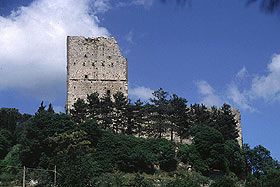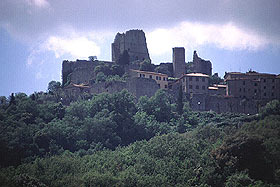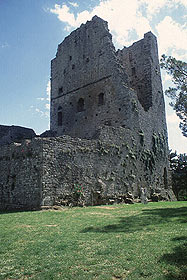Rocca of Civitella Valdichiana
The Rocca viewed from east and from west [Chiana
Valley side] .
|
Civitella in Val of Chiana crowns a hill of 523 meters watershed between
the Valdambra (Ambra Valley) and the Valdichiana (Chiana Valley), in
province of Arezzo. It is reachable from the exit 'Arezzo' of the motorway
A1, from which is about 15 km far.
Click here for more Photos
The mighty ruins of the Rocca di Civitella in Valdichiana
dominate the underlying fortified village. Civitella, crowning one of
the most elevated hills watershed between the Ambra and the Chiana Valley,
is one of the best preserved testimony of the many Longobard fortresses
built between the 6th and the 7th century and strategically set to control
the whole central Italy. The village still has in the layout of its town
walls, almost intact, the characteristic elittical shape of the
military settlements of this type.
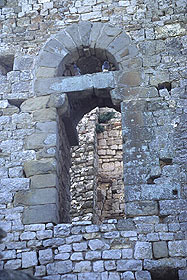 |
Immediately after its foundation Civitella was subdued
to the bishops of Arezzo, at the time it was known as 'Civitella del
Vescovo' [Civitella of the Bishop], and was the chief town of
the medieval military district of the Ambra Valley. In 1289, after the
battle of Campaldino, this area was occupied by the Florentine, to return
few years later again to the bishops. During 13th century the castle,
as so many others in this area, on the occasion of the agreements that
took away the independence of Arezzo for temporary periods, was committed
to the Florentine Republic until the 1384, when it was definitely subjected
to the 'City of the Red Lily'. In 1554, during the 'War of Siena' the
castle withstand the siege of the Imperial troops, also thanks to the
great works of strengthening carried on in the previous years. The state
of downfall in which today the fortification lies is not owed to these
remote war events, but to the destructions perpetuated by the German
Army in 1944, when for retaliation was destroyed great part of the village.
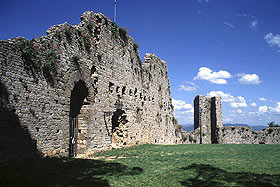 |
Civitella is encircled by the almost intact medieval
town walls, alternated by square towers and endowed with a mighty fortified
gate called 'Porta Aretina'. On the eastern vertex of the hill the walls
are connected to the Rocca, a huge and magnificent building of the 13th
century, erected by the aretine bishop Guglielmino degli Ubertini. The
construction, gifted of high external walled enclosure with a beautiful
gate, is a classical example of medieval quadrangular shaped castle-fence,
with the mighty keep rising up from the western angle of the inner courtyard.
This, although in ruin, has still today strongly visible some decorative
elements that made it one of the finest examples of Tuscan fortified
architecture: the portal with gothic arch, windows with lowered arch,
the high quality of the worked stones and other materials and other technical
particulars are not easily to be found in other constructions of this
age.
|
